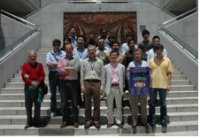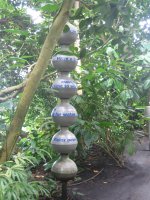Creating polarised positron beams
Today's issue features a story from Tohru Takahashi, a particle physicist and associate professor at Hiroshima University. He is the co-author of "Big-Bang wo tsukuridase" (Making the Big-Bang), a book about the ILC.

Participants of the PosiPol Workshop held in Hiroshima, Japan. |
The PosiPol2008 workshop was held from 16 to 18 June in Hiroshima, Japan. An unfamiliar word, "PosiPol" stands for "polarised positrons", meaning that the "spins" of positrons are aligned when they meet electrons at the centre of a linear collider. The electron beam is designed to be polarised at the ILC, but according to the baseline configuration positrons are unpolarised (or left naturally polarised) because making polarised positron is a difficult task to do.
Read more...
-- Tohru Takahashi |
 |
|
|
 |
Upcoming meetings, conferences, workshops
Joint CesrTA Kickoff Meeting and ILC Damping Rings R&D Workshop (ILCDR08)
Cornell University, USA
8-11 July 2008 34th International Conference on High Energy Physics (ICHEP'08)
Philadelphia, USA
29 July - 5 August 2008
Conference on the Design/ Optimization of the Silicon Detector at the International Linear Collider
University of Colorado at Boulder, Colorado, USA
17-19 September 2008
Upcoming schools
The second Trans-European School for High Energy Physics (TES-HEP)
Buymerhovka, Sumy region, Ukraine
3-9 July 2008
Third International Accelerator School for Linear Colliders (2008 LC School)
Oak Brook, Illinois, USA
19-29 October 2008
|
|
 = Collaboration-wide Meetings = Collaboration-wide Meetings
GDE Meetings calendar
View complete ILC calendar
|
|
|
 |
 |
|
|
 |
From interactions.org: Five million Euros to prepare Europe for the International Linear Collider

ILC-HiGrade will produce a mini series of cavities. |
The partners of the 'ILC-HiGrade' proposal for the European Commission's Seventh Framework Programme have just started a contract for five million Euros funding over the next four years with the European Commission. 'ILC-HiGrade' stands for 'International Linear Collider and High Gradient Superconducting RF-Cavities.' One of the main objectives of the proposal is a small serial production of accelerating cavities, superconducting components made of pure niobium for the planned International Linear Collider (ILC), that reach the high technical standards needed for the planned particle physics project. Other objectives of the ILC-HiGrade proposal are the development of a possible organisation and governance for the ILC and measures to prepare for the actual construction of the machine, including a detailed study on possible sites in Europe.
Read more...
|
 |
|
|
 |
From Scientific American
1 July 2008
As LHC Draws Nigh, Nobelists Outline Dreams--And Nightmares
...Gross said that such a result, going against the standard model, would itself be "enormously exciting." What worried him was finding the Higgs and nothing else, because then it would be impossible to persuade world governments to fund future machines such as the proposed International Linear Collider,
Read more... |
|
From Courier News
1 July 2008
Funding will prevent more Fermilab layoffs
New federal dollars save jobs, restart projects
Read more... |
|
From Frankfurter Allgemeine Zeitung
30 June 2008
Der Urknall von Genf
...Denn was man im Untergrund des schweizerisch-französischen Grenzgebiets zu sehen bekommt, ist die größte Maschine, die sich Physikerhirne je ausgedacht haben – ein Teilchenbeschleuniger und Speicherring der Superlative, ausgestattet mit modernster Technik.
Read more... |
|
From Guardian
30 June 2008
The Big Bang Machine / Cosmic building blocks / The particle menagerie
Today's Guardian features a special supplement on the most incredible scientific experiment ever - the Large Hadron Collider at Cern
Read more... |
|
From Guardian
30 June 2008
Beyond the Standard Model
Experiments at Cern will tackle a dilemma at the heart of modern physics that defeated even Einstein, says Jim al-Khalili
Read more... |
|
|
 |
The ILC-ECFA Workshop in Warsaw

Stefan Pokorski describes various scenarios for physics at a linear collider. |
From 9 to 12 June, the Faculty of Physics at the University of Warsaw, Poland, together with the Institute of Nuclear Studies hosted a workshop under the mandate of the European Committee for Future Accelerators (ECFA) to discuss the physics and detectors for a linear collider. This well attended workshop covered a broad range of topics from the physics of a linear collider to R&D for detectors. The attendants discussed the physics in advance of and preparing for the first results from the Large Hadron Collider (LHC) at CERN that will set the future course for the energy frontier.
Read more...
-- Barry Barish
Director's Corner Archive |
 |
|
|
 |
Cavities around the world

Calling all NewsLine readers with digital cameras! As you are heading off to your various holiday (and vacation) destinations, keep your eyes open for cavity lookalikes like this one, spotted in Cornwall's Eden Project. There are more out there than you think! Send them to communicators@ linearcollider.org and they may show up in NewsLine...
|
|
ILC Note
2008-046
Mechanical tests of Titanium-Stainless Steel bimetallic transition joints
arXiv preprints
0806.4905
Two-Loop QED Heavy-Flavor Contribution to Bhabha Scattering
0806.4560
Applying the POWHEG method to top pair production and decays at the ILC
0806.2698
Leptogenesis in the minimal extension of the Zee-Babu model
|
|

